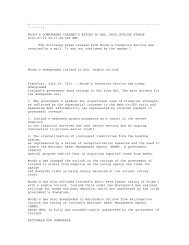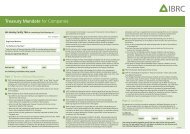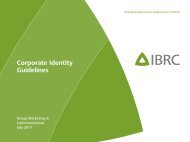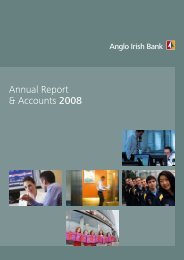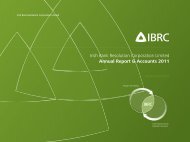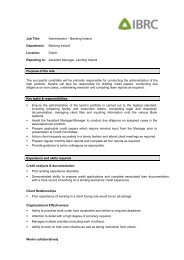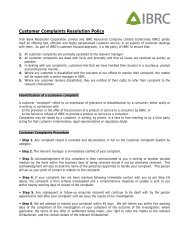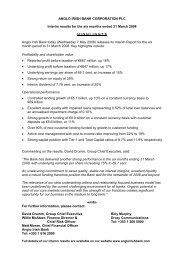Annual Report & Accounts 2009 - Anglo Irish Bank
Annual Report & Accounts 2009 - Anglo Irish Bank
Annual Report & Accounts 2009 - Anglo Irish Bank
You also want an ePaper? Increase the reach of your titles
YUMPU automatically turns print PDFs into web optimized ePapers that Google loves.
Treasury credit risk<br />
<strong>Anglo</strong> <strong>Irish</strong> <strong>Bank</strong><br />
<strong>Annual</strong> <strong>Report</strong> & <strong>Accounts</strong> <strong>2009</strong><br />
At 31 December <strong>2009</strong>, the top 20 customer groups (as defined by the <strong>Irish</strong> Financial Regulator), including loans classified as<br />
held for sale, represented €14.8bn or 21% (30 September 2008: €13.9bn or 19%) of the Group's total loans and advances to<br />
customers and loans classified as held for sale before provisions for impairment. 15 of the top 20 customer groups are<br />
scheduled for transfer to NAMA and included in assets classified as held for sale at 31 December <strong>2009</strong>. Excluding these loans,<br />
the remaining top 20 customer groups represent €8.8bn or 24% of the Group's loans and advances to customers before<br />
provisions for impairment.<br />
The Treasury Credit Risk team manages credit risk inherent in all Group Treasury business including interbank activity, derivative<br />
transactions and investment in debt securities. The Group's policy on treasury credit risk is set out in a detailed credit policy<br />
that has been approved by the Risk and Compliance Committee. Limits are assessed and proposed by an independent credit<br />
team within Group Risk Management and are presented for consideration at the weekly Treasury Credit Committee meeting.<br />
The Group uses external ratings and market information, supplemented by internal analysis, to assess the risks associated with<br />
treasury assets. The performance of all asset-backed securities is monitored closely through monthly trustee reports and rating<br />
agency commentary. Impairment is monitored on a monthly basis and recognised when there is objective evidence that a<br />
specific financial asset is impaired. A range of factors are used in recognition of impairment, which can vary depending on the<br />
nature of the underlying assets or collateral but will typically include a significant or prolonged decline in the fair value of the<br />
security, the level of over-collateralisation, and adverse credit ratings action.<br />
Settlement risk arises in any situation where a payment in cash or securities is made in the expectation of a corresponding<br />
receipt in cash or securities. The settlement risk on many transactions, particularly those involving securities, is substantially<br />
mitigated when effected via assured payment systems or on a delivery-versus-payment basis. Each counterparty's credit profile<br />
is assessed and clearing agents, correspondent banks and custodians are selected with a view to minimising settlement risk.<br />
The most significant portion of the Group’s settlement risk exposure arises from foreign exchange transactions. Daily settlement<br />
limits are established for each counterparty to cover the aggregate of all settlement risk arising from foreign exchange<br />
transactions on a single day.<br />
For the majority of the Group's interbank counterparties, settlement risk is effectively eliminated through the use of Continuous<br />
Linked Settlement ('CLS'). CLS is a real-time, global settlement system which minimises settlement risk and is operated by CLS<br />
<strong>Bank</strong>, which is supervised and regulated by the US Federal Reserve.<br />
Treasury credit risk is also influenced by country risk, where country risk is defined as the risk that circumstances arise in which<br />
customers and other counterparties within a given country may be incapable of, or precluded from, fulfilling their obligations<br />
to the Group due to economic or political circumstances. Group Risk Management sets appropriate country risk limits, taking<br />
into consideration independent credit information from well established international sources. These limits reflect the country’s<br />
overall credit worthiness and are monitored on an ongoing basis. Country concentrations are addressed through the country<br />
risk policy, which specifies risk appetite by country and avoids excessive geographic risk concentration.<br />
119






